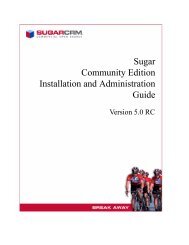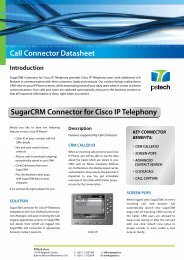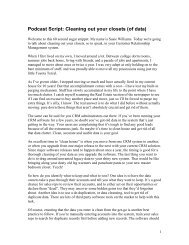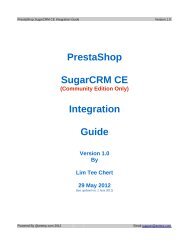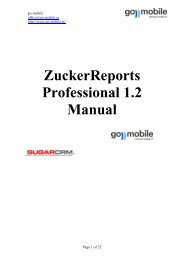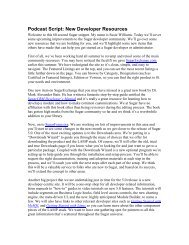Sugar Community Edition Installation and ... - SugarForge
Sugar Community Edition Installation and ... - SugarForge
Sugar Community Edition Installation and ... - SugarForge
You also want an ePaper? Increase the reach of your titles
YUMPU automatically turns print PDFs into web optimized ePapers that Google loves.
Developer Tools2. Create a module using one of the following templates that <strong>Sugar</strong> provides for you.Basic. This template provides basic fields such as ID, Date Entered, <strong>and</strong> CreatedBy. Use this template to create a module from scratch.Company. This template provides organization-specific fields such as CompanyName, Industry, <strong>and</strong> Billing Address. Use this template to create a module that issimilar to the Accounts module.File. This template provides document-specific fields such as File Name <strong>and</strong>Document Type. Use this template to create a module that is similar to theDocuments module.Issue. This template provides case <strong>and</strong> bug-specific fields such as ID,Description, <strong>and</strong> Created By. Use this template to create a module that is similar tothe Cases module or Bug Tracker module.Person. This template provides individual-specific fields such as salutation, title,name, address, <strong>and</strong> phone number. Use this template to create a module that issimilar to the Contacts module or the Leads module.Sale. This template provides opportunity-specific fields such as Lead-Source <strong>and</strong>Probability. Use this template to create a module that is similar to theOpportunities module.3. Create new fields, if necessary. You can also rename default fields from thetemplate.Note:Apart from field names, you cannot edit other field properties in a template.However, you can duplicate the fields <strong>and</strong> save them with a different name tocustomize them. You can choose which fields appear in the module layouts.4. Customize page layouts for List View, Edit View, Detail View, Sub-panels, Searchform, <strong>and</strong> <strong>Sugar</strong> Dashlets, if necessary.5. Create relationships between the new module <strong>and</strong> other modules, if needed. A<strong>Sugar</strong> module, typically, has multiple relationships with other <strong>Sugar</strong> modules.When you create a custom module, you can define its relationship with other<strong>Sugar</strong> modules.6. Save the package <strong>and</strong> distribute it.You can choose one of the following options to distribute the package:Publish. This option is designed for distribution to specific users orcustomers. The system creates a zip file, which you can save on your localmachine. You can then email it to one or more individuals who can use theModule Loader to upload the zip file into their <strong>Sugar</strong> instance.After the module is installed through Studio, you can add or remove fields <strong>and</strong>make other changes to a published module.Deploy. This option is designed to install the custom module on your <strong>Sugar</strong>instance <strong>and</strong> make it available to users in your organization. Through Studio,you can add or remove fields <strong>and</strong> make other changes to a deployed module.Export. This option is designed for distribution to developers. The systemcreates a zip file, which you can save on your local machine <strong>and</strong> email to<strong>Sugar</strong> <strong>Community</strong> <strong>Edition</strong> <strong>Installation</strong> <strong>and</strong> Administration Guide69




